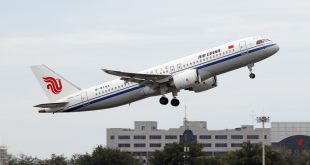Published: July 18,2024
By Liu Chunsheng

Wind power equipment waiting to be exported at the Port of Lianyungang in
Jiangsu Province, China, May 25, 2024. /CFP
In the first half of 2024, China’s economy continued its path of steady progress
towards high-quality development, marking a new chapter of growth. Despite
uncertainties in the world economic environment, weak global growth
momentum, and the complexity of domestic structural adjustments, the Chinese
economy maintained a stable growth rate and achieved significant improvements
in quality.
China’s GDP reached 61.68 trillion yuan (about $8.65 trillion), with a year-on-year
growth rate of 5 percent in terms of comparable prices in the first six months of
- This growth rate surpassed that of other major economies globally,
showcasing the resilience and potential of the Chinese economy. Against the
backdrop of high-quality development, industrial upgrading in China has
accelerated.
The value-added of industries above a designated scale increased by 6.0 percent,
with the value-added of equipment manufacturing growing by 7.8 percent and
high-tech manufacturing by 8.7 percent, outstripping the general industrial
growth by 1.8 and 2.7 percentage points, respectively. This demonstrates the
country’s shift towards high-end, intelligent, and green-oriented manufacturing,
enhancing new productive forces.
Representing emerging strategic industries, the new energy vehicle sector
maintained strong growth momentum. Data reveals a significant year-on-year
increase of 34.3 percent in the production of new energy vehicles, reflecting
notable progress in China’s new energy vehicle sector and the expanding market
demand. The rapid development of new energy vehicles not only drives structural
upgrades in the automotive industry but also promotes the widespread adoption
of clean energy and the achievement of energy-saving and emissions-reduction
goals.
Strategic emerging industries such as high-end equipment manufacturing and
aerospace equipment manufacturing continued to grow. For instance, the value-
added of aerospace equipment manufacturing increased by 10 percent, indicating
significant advancements in China’s high-end manufacturing sector, enhancing
overall industrial competitiveness and technological levels.
New technologies such as big data and artificial intelligence have been widely
applied across various sectors, giving rise to new consumption scenarios and
business models. Trends like live-streaming e-commerce and instant delivery have
boosted the rapid growth of online retail sales of physical goods, stimulating both
consumer market prosperity and the deepening of the digital economy.
A smart factory producing ultra-thin monocrystalline silicon solar cells in Yinchuan, Ningxia Hui
Autonomous Region, China, January 28, 2024. /CFP
Clean energy production experienced rapid growth, contributing to positive
advancements in energy conservation and carbon emissions reduction. In the first
half of the year, the combined hydroelectric, nuclear, wind, and solar power
generation of large-scale industries increased by 13.4 percent year-on-year with a
rising proportion of electricity generation from these sources in large-scale
industries.
Additionally, energy consumption per unit of GDP continued to decline,
showcasing notable achievements in green development and laying a solid
foundation for achieving carbon peak and carbon neutrality goals.
Across regions and sectors, the pursuit of high-quality development remains the
primary objective, with efforts focused on driving momentum transformation,
structural upgrades, and efficiency improvements. The emergence of new
technologies, industries, formats, and models inject fresh vitality and impetus into
economic development.
Sectors such as wholesale and retail, accommodation and catering,
transportation, and information transmission witnessed significant increases in
employment numbers, serving as vital areas for job creation. Moreover, with the
rapid evolution of the digital economy and intelligent manufacturing,
employment growth in high-tech industries and strategic emerging industries has
been particularly notable, offering high-quality job opportunities in the
employment market.
Amid a global economic recovery with weak momentum, China’s foreign trade
commenced strongly, with exports maintaining steady growth. In the first half of
the year, the total volume of imports and exports reached 21.17 trillion yuan,
marking a 6.1 percent year-on-year increase, with exports reaching 12.13 trillion
yuan, up by 6.9 percent.
The exports of private enterprises surged by 11.2 percent, accounting for 55
percent of the total volume, a 2.5-percentage-point increase from the same
period last year. Machinery and electrical product exports increased by 8.2
percent, constituting 58.9 percent of total exports, suggesting ongoing
optimization of China’s export commodity structure.
China’s trade patterns exhibit characteristics of regional differentiation, with
steady export growth to ASEAN and faster export growth to regions such as Asia,
Africa, Latin America, and countries participating in the Belt and Road Initiative.
This indicates positive progress in diversifying China’s market layout and providing
robust support for the sustainable and stable development of foreign trade.
In response to the complex and changing domestic and international
environment, China’s macro policies continued to exert force, providing robust
support for economic recovery. Financial and monetary policies worked in
tandem, intensifying countercyclical adjustments to effectively mitigate
downward economic pressures. Additionally, deepening supply-side structural
reforms havefacilitated new advancements in high-quality development.
Looking ahead to the second half of the year, China’s economic development will
continue to face numerous challenges and uncertainties, such as the rising
instability and uncertainty in the external environment, and insufficient effective
domestic demand, among others. Nevertheless, the fundamental strengths of
China’s economy, coupled with favorable conditions for high-quality
development, remain robust.
Liu Chunsheng, a special commentator on current affairs for CGTN, is an
associate professor at the Beijing-based Central University of Finance and
Economics
 Africa -China Review Africa -China Cooperation and Transformation
Africa -China Review Africa -China Cooperation and Transformation
